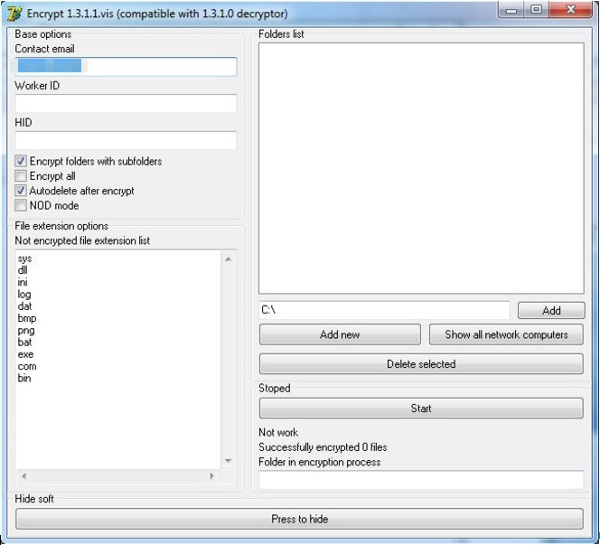RANSOM_CRYPICH.EV
Trojan.Win32.Filecoder.bz (Kaspersky); Troj/Ransom-EKQ (Sophos-Lite); Generic.Ransom.Cryak.A02E7E6F (Bitdefender)
Windows


Threat Type: Trojan
Destructiveness: No
Encrypted: No
In the wild: Yes
OVERVIEW
Dropped by other malware, Downloaded from the Internet
This Trojan arrives on a system as a file dropped by other malware or as a file downloaded unknowingly by users when visiting malicious sites.
It uses a user interface (UI).
It drops files as ransom note.
TECHNICAL DETAILS
574,976 bytes
EXE
No
10 Jul 2017
Encrypts files, Displays message/message boxes
Arrival Details
This Trojan arrives on a system as a file dropped by other malware or as a file downloaded unknowingly by users when visiting malicious sites.
Other Details
This Trojan uses the following user interface:
- Encrypt 1.3.1.1.vis (compatible with 1.3.1.0 decryptor)
It does the following:
- It encrypyts all files in specific folders specified by the user
- It can be configured to encrypt the files within the subfolders of the specified folders
- It can be configured to encrypt all files in all drives
- It can be configured to delete itself after execution
- It can be configured to hide the number of files encrypted or show it (NOD mode)
- It can be configured to avoid specific files by inputting extension names
- It can be configured to add shared folders from network computers in the list for encryption
- It can be configured to be hidden while encryption is ongoing
- It can be configured to add a specific string for the renamed file name (HID)
Ransomware Routine
This Trojan renames encrypted files using the following names:
- email-{BLOCKED}r@tuta.io.ver-CL 1.3.1.0.id-{HID}@@@@@8865-D26E.randomname-{30 random uppercase letters}.{3 random uppercase letters}.{3 randomlowercase letters}
It drops the following file(s) as ransom note:
- {folder of encrypted files}\README.txt
It leaves text files that serve as ransom notes containing the following text:
- Do you want to return your files? Write on mail: {BLOCKED}r@tuta.io I accept payment in bitcoins. What is bitcoin? Read here: https://bitcoin.org/en/faq
NOTES:
Displays the following GUI:

SOLUTION
9.850
13.574.04
10 Jul 2017
13.575.00
11 Jul 2017
Step 1
Before doing any scans, Windows XP, Windows Vista, and Windows 7 users must disable System Restore to allow full scanning of their computers.
Step 2
Note that not all files, folders, and registry keys and entries are installed on your computer during this malware's/spyware's/grayware's execution. This may be due to incomplete installation or other operating system conditions. If you do not find the same files/folders/registry information, please proceed to the next step.
Step 3
Identify and terminate files detected as RANSOM_CRYPICH.EV
- Windows Task Manager may not display all running processes. In this case, please use a third-party process viewer, preferably Process Explorer, to terminate the malware/grayware/spyware file. You may download the said tool here.
- If the detected file is displayed in either Windows Task Manager or Process Explorer but you cannot delete it, restart your computer in safe mode. To do this, refer to this link for the complete steps.
- If the detected file is not displayed in either Windows Task Manager or Process Explorer, continue doing the next steps.
Step 4
Search and delete these files
- {folder of encrypted files}\README.txt
Step 5
Scan your computer with your Trend Micro product to delete files detected as RANSOM_CRYPICH.EV. If the detected files have already been cleaned, deleted, or quarantined by your Trend Micro product, no further step is required. You may opt to simply delete the quarantined files. Please check this Knowledge Base page for more information.
Step 6
Restore encrypted files from backup.
Did this description help? Tell us how we did.

